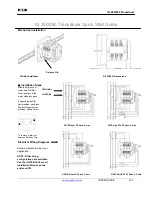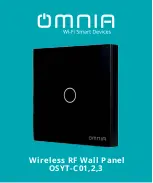
TIMTER™ Multi-mode Digital Telemetry Transmitter
29
Quasonix, Inc.
3.2 Thermal
It is important that the bottom surface (on the face opposite the product label) be securely attached to a baseplate
capable of dissipating the power produced by the transmitter model in use. This mounting baseplate must be flat,
smooth, and clean. Contact Quasonix for the heat sink power dissipation required for your transmitter model.
ATTENTION: Do not operate the transmitter without a proper heat sink.
Failure to do so may lead to permanent damage to the unit and will void the
warranty.
Overheating can occur in a matter of seconds when a transmitter is
not properly heat-sinked. In absolutely no case should any type of stickers or
labels be applied to the bottom surface of the transmitter.
The heat sink required for a particular transmitter depends heavily on the installation. Factors such as altitude, air
temperature, air flow, and mass of the mounting surface all have a substantial impact on the flow of heat away from
the transmitter. Quasonix offers several types of integrated and add-on heat sinks (refer to Section 0). Please contact
Quasonix for heat sink recommendations for your particular TIMTER™ transmitter.
Regardless of the heat sink, Quasonix strongly suggests using a thermal pad, such as Q-Pad
®
II from Bergquist.
3.3 Electrical
The standard TIMTER™ has two external connectors, an MDM-15 type connector known as the primary, and an
SMA female for the RF output connection. Certain transmitter options may require additional connectors.
The pin numbering and pin assignments for the transmitter connectors vary depending on the interface type,
connector gender, and options ordered. A pinout
code
is assigned based on transmitter type and options. Section 1.2
describes the nomenclature/part number breakdown for transmitters.
Each pinout drawing contains the pinout code, a description of the connector (such as Female MDM-15), a
photograph of the connector with the pins numbered appropriately, and a table showing the designated pin
assignments, drawing name, and revision. Drawings may contain more than one connector (such as an MDM-15 and
an MDM-9) depending on the application.
A sample pinout drawing is shown in Figure 21. This is only an example. Pinout drawings for all transmitters may
be obtained from the Quasonix web site. Customers with security rules that prevent Internet access or file downloads
may contact Quasonix Customer Service for assistance.
1.
Select Resources from the menu bar.
2.
Click on Product Drawings.
3.
Select Product Category > Transmitters, Drawing Type > Pinouts.
4.
Type the pinout code in the Search box and press Enter.
5.
Click on the link or the pdf icon in the list.
When you click on the pinout link in the list, it should open the file in a new tab in the same browser
window. Some applications may only allow downloads, but most browsers allow viewing, depending on
Содержание TIMTER QSX-V Series
Страница 39: ...TIMTER Multi mode Digital Telemetry Transmitter 31 Quasonix Inc Figure 22 Baseband Signal Timing ...
Страница 101: ...TIMTER Multi mode Digital Telemetry Transmitter 93 Quasonix Inc Figure 41 Shock Pulse X axis Negative ...
Страница 109: ...TIMTER Multi mode Digital Telemetry Transmitter 101 Quasonix Inc Figure 42 Transmitter Clock and Data Logic ...
















































